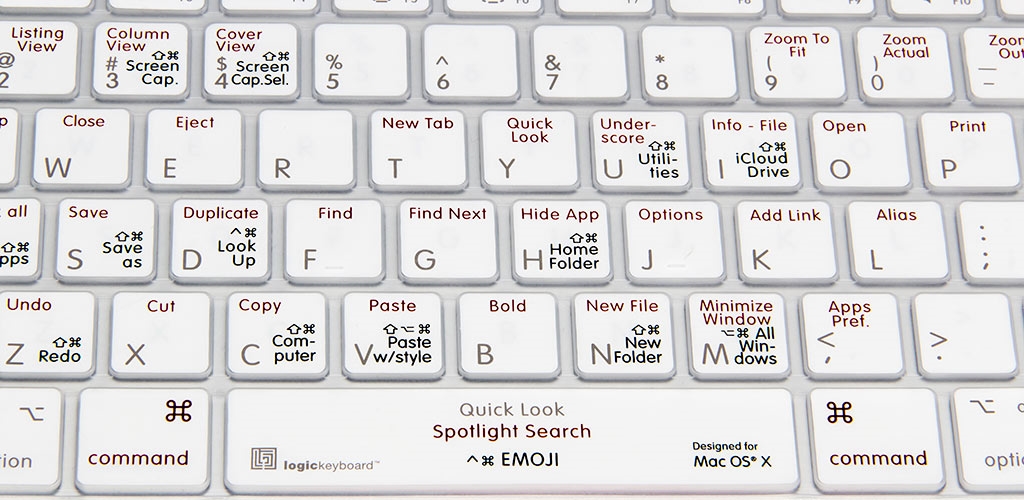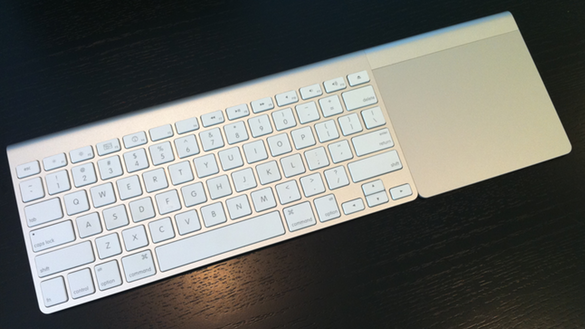Keyboard And Trackpad Shortcuts For Mac
10 Ways To Navigate Mac OS X Using Just The Keyboard and Gestures It’s possible to use your Mac much more quickly and effectively, simply by ditching the mouse and learning some of the most common keyboard shortcuts and trackpad gestures. A replacement of the top half of the bottom case, includes a replacement keyboard. And trackpad, so that is often the cure to a keyboard or trackpad issue.
Transform your phone into a wireless mouse, keyboard and trackpad for your computer, it enables you to control your PC/Mac/Linux effortlessly through a local network connection. WiFi Mouse can replace your real mouse, keyboard or controller when they are broken.
Now you can relax on the sofa and control playing movie in the comfort of your own home. Key features: ● Fully Simulated Mouse ● System keyboard input text ● Simulated Computer Keyboard (support combination keys) ● Magic touchpad ● Multi-Touch Gestures ● Shutdown / Sleep / log off / restart PC/MacBook Remotely ● Remote media controller (support YouTube, VLC, Spotify and etc) ● Voice Input Remotely ● Application Launcher ● Browse and open computer files. ● Screen capture ● Game controller ● Password protection ● Control PPT / Keynote Presentation Remotely ● Compatible with Windows 7/8/10, macOS/Linux Quick setup: ● Download & install mouse server from website ● Make sure your phone and computer at the same network. ● Start app to connect one computer ● Now you can control your computer with mouse, keyboard, touchpad and more features. Drummerboy89, Not made for iPhone X This seems to be a pretty well made WiFi mouse app. At least the back-end stuff works well.

Unfortunately, the iPhone X introduced yet another screen size into the mix, which is the bane of any UI developer’s existence. This app has not been adjusted to handle the iPhone X’s screen size. So far, the only part I’ve noticed that doesn’t work quite right is the “simulated keyboard”, which is a $1.99 in-app purchase. If the app gets an update that fixes this issue, I’ll update this review.
Until then, if you have an iPhone X, I’d suggest you get this app as only a mouse and simple phone-style keyboard (which is included with the free version). Don’t expect to be able to use the Mac-style keyboard. Developer Response, Hi, we have fixed iPhone X issue, please update this app. Any question please contact us. Drummerboy89, Not made for iPhone X This seems to be a pretty well made WiFi mouse app. At least the back-end stuff works well. Unfortunately, the iPhone X introduced yet another screen size into the mix, which is the bane of any UI developer’s existence.
This app has not been adjusted to handle the iPhone X’s screen size. So far, the only part I’ve noticed that doesn’t work quite right is the “simulated keyboard”, which is a $1.99 in-app purchase. If the app gets an update that fixes this issue, I’ll update this review. Until then, if you have an iPhone X, I’d suggest you get this app as only a mouse and simple phone-style keyboard (which is included with the free version). Don’t expect to be able to use the Mac-style keyboard.

Developer Response, Hi, we have fixed iPhone X issue, please update this app. Any question please contact us.
As the Cult of Mac and other websites recommend, there are Mac keyboard shortcuts you should know and use. But if you want to be a Mac power user and, I contend you shouldn’t spend time pressing keyboard shortcuts when there are faster ways to do it.
I rarely punch keyboard shortcuts, mainly because I don’t like having to remember them, and I typically want to menu items and shortcuts while my fingers are the main keys or on my trackpad. And I definitely don’t like moving my hand from my trackpad in order to punch shortcuts. So instead of typing keyboard shortcuts, I use string triggers, finger gestures,. For this article I assume that you are familiar with how to use keyboard shortcuts. If not, you can review them in a recent.
You may or may not be familiar with Keyboard Maestro and BetterTouchTool, and that’s okay. This article will show you what’s possible with both of these applications and why you should learn how to use them. My method of triggering keyboard shortcuts depends whether my hand is on my keyboard or my trackpad. Triggering Mac Shortcuts Quitting (and Hiding) Applications Command+Q and Command+H: Quits or Hides the frontmost application. I rarely punch these shortcuts. Instead I use these three methods: SuperTab quits (and/or hides) selected applications like, App Store, and Notebook after they have been unused in the background for a specified amount of time. BetterTouchTool: If my hand is my trackpad, I do a Five Finger Click to quickly close an application.
This method keeps me from having to move my hand back to the keyboard to type the shortcut. (Note: BTT has dozens of available finger gestures to choose from. You don’t have to use the ones I selected for an action.) Learn more BetterTouchTool. Open or Close a Web Browser Tab Command+T / Command+W: Opens/closes a tab in a web browser. BetterTouchTool: I can use a TipTap Right on my trackpad to open a new tab window. But I rarely do that either. I have about 13 websites that I regularly visit.
Photoshop Shortcuts For Mac
So I use a Three Finger Click in Safari to trigger a Keyboard Maestro palette to select and open my most visited websites. These triggers open the selected website in a new browser. The following video shows how that’s done. Alfred: Most of the time I need to open a new browser tab would be do a search or go directly to a specific website not in my KM palette. To perform these actions, I try to use Alfred to do web searches and open websites. These Alfred triggers also open a new tab browser window during the search.
Looking down to locate the Command+T shortcut is not as fast as using Alfred or BetterTouchTool. Switch Between Applications Command+Tab: This shortcut triggers the default Application Switcher, which enables you to switch between applications. But the problem I have with the Application Switcher shortcut is that you have to keep the keys held down as you navigate the Switcher. With my Keyboard Maestro and BetterTouchTool setup, I don’t have to do that. Instead of punching Command+Tab, I use a Two-Finger Click to trigger Keyboard Maestro’s Application Switcher. The KM switcher not only includes the icons of open applications, it includes applications that I always want to be included whether they are closed or open. If I want to trigger KM switcher while my fingers are on the keyboard, I type a (apsw) or I can use type the Command+Tab to trigger it.
Mainly though I switch applications when my hand is on my trackpad, so I use the BTT trigger. In the following video, I explain how to use the Keyboard Maestro Application Switcher: SuperTab: I also trigger applications and other items that I can quickly access in SuperTab. Cut, Copy and Paste Command+X, Command+C, Command+V: These commands respectfully cut, copy, and paste selected text, but I can’t punch them without looking down at the keyboard to find the keys, so I use other methods to trigger these shortcuts.: Most of the time, I use, especially since my hand is already on my trackpad when I selecting and copying text.
Keyboard Maestro: if my hand is already on the keyboard, I can more easily paste the text I copied. I simply type “vv”, which triggers the Command+V shortcut. BetterTouchTool: If my hand is on the trackpad and I need to paste the last item copied, I can also do a Three Finger Clickswipe Down to paste that text. I can also use a Three Finger Swipe Down which triggers the mini widow so that I can select and paste from a menu of previously copied items.
Take Mac Screenshots Command+Shift+4, Command+Shift+3: the first shortcut takes a of any area of on your screen that you select, and second shortcut captures the entire screen. BetterTouchTool: since my hand needs to be on my trackpad when I want to take a screenshot, I can use a Three Finger Swipe Up to trigger the shortcut. But typically I don’t trigger Apple’s default screen capture application. Instead, I trigger a capture, because it automatically opens a quick view of the screenshot, instead of placing the shot on my desktop.
If I need to take a regular default screenshot, I use a Three Finger Swipe Up+ to trigger the shortcut. SuperTab: It’s very rare that I need to capture the entire screen, but when I need to, I trigger the shot using its screen capture feature. For MAT readers, and you can also download a 30-day trial. SuperTab is an affiliate link. Thanks for your support.
SuperFast Alfred: for even a faster way, I use an that allows me to type a keyword and it sets up a timed full screen shot. Open Finder Folders Command+Shift+H, Command+Shift+A, Command+Shift+U, and Command+Shift+D: these shortcuts respectfully open the Home, Applications, Utilities, and Desktop folders from within the Finder. But again, I don’t use them. BetterTouchTool: Instead of remembering the above shortcuts, I just click on my desktop which opens the Finder, and then do a Four Finger Tap to open a New Finder Window, and then go to the folder I need.
If I needed to navigate to folders regularly, I could set up finger gestures to navigate to them. Alfred: I also use Alfred to quickly get to a particular folder, such as the Utilities or Applications folder. This is much quicker than looking down at my keyboard to locate the keys I need. No Limits I use the applications I describe above to trigger shortcuts and menu items in nearly all the applications I use. Whenever I find myself dragging my cursor to click a menu item, I always see how I can trigger that item using one of my applications. Your Feedback Let me know how much you use keyboard shortcuts, and if you trigger them using other methods besides pressing the keys.